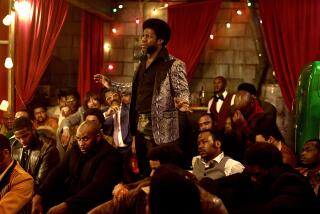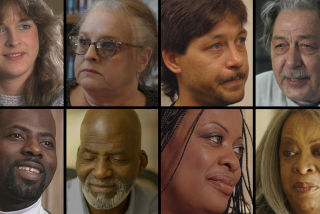Telling This Couple’s Story Was a Seven-Year Labor of Love
- Share via
NEW YORK — The strangest thing about meeting stars is that you feel as if you already know them. You don’t, of course. The same is true, only to a far greater degree, when Bill Sims, Karen Wilson and their two daughters, Cicily and Chaney, sit down to discuss “An American Love Story,” a 10-part, 10-hour documentary that is about . . . them. It has already screened, and been critically embraced, at various film festivals.
“People ask you questions that somebody would ask if you knew them as a friend for a really long time, but you don’t know them,” Cicily says. “So it’s like, ‘Who are you?’ It’s weird.”
“What they know about us is very superficial,” Bill says. “And some of the things they say, [about] my drinking, how could I talk about that stuff? Everybody who knew me knew I had a drinking problem.”
Now an even larger audience will probably start acting overly familiar as the documentary begins a five-night national broadcast run on PBS this Sunday. The director, Jennifer Fox, and co-producer Jennifer Fleming shot more than 1,000 hours of footage over 18 months and conducted 400 hours of interviews over seven years to document a family representing that much debased term “family values,” while simultaneously flying in the face of the typical American family. Bill, 43 at the time of filming, in 1992, is a African American blues musician. Karen, who was 42, is a white corporate administer. They live in Queens, N.Y., where they raised Cicily, a 20-year-old senior at Colgate, and Chaney, 12.
As Fox is the first to admit, not much happens in the movie. The family does what families do: eating, lounging, visiting friends and relatives. Among the highlights: Cicily makes a racially loaded class trip to Africa. Chaney goes out on her first date. Karen has a hysterectomy. Bill checks in with his son from another relationship, who has been arrested for drug trafficking. Perhaps most dramatically, Bill and Karen return to Marion, Ohio, where they met in the late ‘60s and where the audience learns how much resistance they encountered when they started seeing each other.
“One night they stopped me,” Bill says. “There were 12 or 15 sheriffs around my car. They put me in the car and then locked me up. They wouldn’t let my dad come get me--her mom had to. So the next morning they bring in this guy from the state hospital. He had a mask on because he’s got tuberculosis. They took his mask off and threw him in the cell with me and stood back laughing. That was just a real crazy situation.”
The documentary would seem to be about race, and it is, but as it proceeds it becomes much more than that. Originally, Fox, a white documentarian who made the celebrated “Beirut: Last Home Movie,” was inspired by her own relationship with a black man. She decided to make an hourlong film that included her and three other interracial couples. Then she met Bill and Karen. Because she didn’t have the resources to treat the other couples in depth, Bill and Karen became the focus, and the project ballooned to 13 hours.
Speaking Honestly--and Politically Incorrectly
“We clicked very quickly,” Fox says. “With Bill, immediately I saw, ‘Oh, this is a man who’s going to go there.’ That first interview he talked about how when he was a kid the older guys would tell him how to ‘pull’ white girls--meaning, how to get a white girl. He was speaking about things that were totally politically incorrect. And I appreciate that. Let’s tell the truth here. And Karen, maybe I was attracted to her cuteness and her joie de vivre. “
Another reason the couple appealed to Fox was that she was looking for a family that worked, as opposed to the Louds, the dysfunctional upper-middle-class white family so memorably depicted 20 years ago in “An American Family.” There’s a sort of ancient social truism underscored by the fact that Bill and Karen, who had everything going against them--except their values--made it, while the Louds, with all the material benefits in the world, didn’t.
And then, too, there’s a more sensitive but no less compelling aspect to Bill and Karen. It’s there in the scenes where Karen is chatting amiably with Bill’s relatives, and in Bill’s style and cooking: Karen didn’t try to become “black,” and Bill didn’t try to become “white.” It turns out that despite their obvious differences they’re coming from the same place.
A Sympathetic Husband, a More Distant Wife
“I loved them as a subject, because he’s really black and she’s really white,” Fox says. “It’s about difference and maintaining difference and still relating. A lot of the couples I met were more white and living in a white, affluent world. For me the future is not about us all becoming one color.”
As good as Bill and Karen were as subjects, there were bumps in the road, and they show on film. While Bill comes across as warm and sympathetic, Karen is more remote and opaque. In part this is because she didn’t like being interviewed, whereas Bill treated it almost as therapy. It also has something to do with their personalities. Karen skims along the surface. Bill digs down deep. However, Fox hastens to point out that while Karen may have been reluctant to let the audience into her heart, she did let them into her apartment. Fox and Fleming literally slept there for more than a year. She even agreed to allow the filmmakers to deal with Bill’s alcoholism.
“I didn’t see Bill like that, an alcoholic,” Karen says. “That was not the person I knew. I didn’t want people to think all black men are alcoholics, and he wasn’t like that as a father and husband.”
“It didn’t bother me, because it was part of my life,” Bill says evenly. “You agree to do a documentary, that’s part of it.”
They agreed to the documentary--because they thought it would be interesting and fun--but with the caveat that they had final cut, an unusual arrangement that, as Fox puts it, “leveled the playing field.” However, the family did not see the raw footage or the interviews, only Fox’s rough cut, about which they had few quibbles. In fact, Fox was more constrained by the film’s aesthetic ground rules. She felt she could examine only those issues raised by the verite footage. For example, questions about Karen’s childhood could not be explored because there was nothing in the footage to justify it, no reminiscing between, say, Karen and her mother. The circumstances surrounding Cicily’s birth out of wedlock, perhaps the most important event in their lives, are treated glancingly for the same reason.
The film is also unusual in that the family speaks to the camera and acknowledges the filmmakers. Bill and Karen say they insisted that it be this way over Fox’s objections. Fox, however, says it was her choice, that she finds the fly-on-the-wall documentary convention a distortion of reality.
At any rate, what the viewer does not see and can only imagine is the single-mindedness it took Fox to put this project together. At first it was 26 half-hour segments. Then it was 13 half-hours. Then it became three hours. Then it was back to 13. Then it went down to nine. Finally, when Fox and her colleagues assembled the episodes, they realized that the story had a hole in it, so they added one more, making the series an even 10. All of this back-and-forth was not a case of indecision, but rather a response to the ebb and flow of funding and support.
And now, after seven years, Chaney is a college freshman. Cicily is engaged to be married. Karen says she’s put on 35 pounds. Bill, who is sober, shaved his head and became a vegetarian, frustrating viewers who come to him for recipes to those meals he cooked on camera so long ago. His musical career is flourishing because of the series too.
What hasn’t changed, sadly, is the racial climate in America. One of the unstressed points in “An American Love Story” is that when Bill and Karen got together it was the height of the civil rights movement, and they were riding the wave of the future. It was a future that never happened. Now Bill wonders whether, after the series airs, they should move, so that the racists out there won’t find them.
Karen is not too sure they should do this, but says to him, “I’ll go where you are.”
* “An American Love Story” airs Sunday at 9 p.m. on KCET and KVCR and continues through Thursday at 9 each night. Additional information about interracial relationships available at: https://www.pbs.org/lovestories.
More to Read
The complete guide to home viewing
Get Screen Gab for everything about the TV shows and streaming movies everyone’s talking about.
You may occasionally receive promotional content from the Los Angeles Times.






